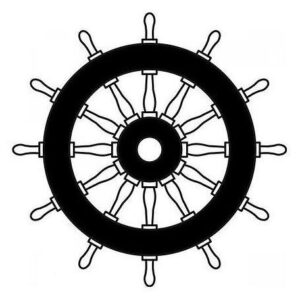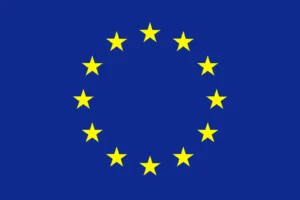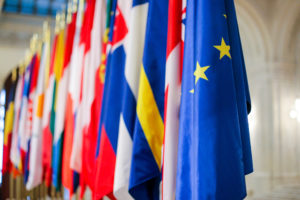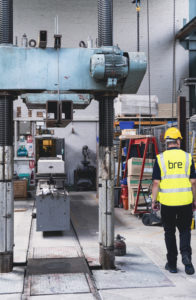What is the Marine Equipment Directive?
The Marine Equipment Directive (MED) is a requirement to gain accreditation (The Wheelmark symbol) for equipment placed on board ships. Once a product gets approval, safety certificates are then issued by, or on behalf of, member states of the European Union.
The Annex to Commission Implementing Regulation provides the design, construction and performance requirements, and testing standards for marine equipment, which the Official Journal of the European Union publishes. It covers all types of marine equipment that fall under the International Conventions developed by the European Maritime Safety Agency (EMSA).

Products covered by the directive which BRE Global Ireland can certify:
- MED/3.10 – Nozzles for fixed pressure water spraying fire extinguishing systems for machinery spaces and cargo pump- rooms
- MED/3.1 – Primary decks covering
- MED/3.2 – Portable fire extinguishers
- MED/3.36 Fire dampers on high speed craft
- MED/3.51 Fixed fire detection and fire alarm systems components for control stations, service spaces, accommodation spaces, cabin balconies, machinery spaces and unattended machinery spaces
- MED/3.11 “A” & “B” Class divisions fire integrity
- MED/3.13 Non -combustible materials
- MED/3.16 Fire Doors
- MED/3.17 Fire door control systems components.
- MED/3.18 Surface materials and floor coverings with low flame – spread characteristics
- MED/3.22 Fire dampers
- MED/3.25 “A” and “B” class fire proof windows and side schuttles
- MED/3.26 Penetrations through “A” class divisions (a) electric cable transits, (b) pipe, duct, trunk, etc penetrations
- MED/3.27 Penetrations through “B” class divisions (a) electric cable transits, (b) pipe, duct, trunk, etc penetrations
- MED/3.28 Sprinkler systems (limited to sprinkler heads). Type examination using Notified INAB Registration No. 6023 Page 5 of 21 Edition 10, 28/10/2021 (Nozzles for fixed sprinkler systems, for high speed craft (HSC) are included under this item)
- MED/3.29 (a) Non – percolating lay flat firefighting hoses (range of the inside diameter from 25 mm to 52 mm)
- MED/3.32 Fire restricting materials (except furniture) for high speed craft
- MED/3.33 Fire restricting materials for furniture for high speed craft
- MED/3.34 Fire resisting divisions for high speed craft
- MED/3.35 Fire doors on high speed craft
- MED/3.37 Penetrations through fire resisting divisions on high speed craft (a) electric cable transits, (b) pipe, duct, trunk etc penetrations
- MED/3.38 Portable fire – extinguishing equipment for lifeboats and rescue boats
- MED/3.39 Nozzles for equivalent water -mist fire extinguishing systems for machinery spaces and cargo pump rooms
- MED/3.42 Inert gas systems components
- MED/3.43 Nozzles for deep fat cooking equipment fire extinguishing systems (automatic or manual type)
- MED/3.43 Nozzles for deep fat cooking equipment fire extinguishing systems (automatic or manual type)
- MED/3.45 Equivalent fixed gas fire extinguishing systems components extinguishing medium, head valves and nozzles) for machinery spaces and cargo pump rooms
- MED/3.46 Equivalent fixed gas fire extinguishing systems for machinery spaces (aerosol systems)
- MED/3.47 Concentrate for Fixed High Expansion Foam Fire Extinguishing Systems for Machinery Spaces and Cargo Pump Rooms
- MED/3.48 Fixed water based local application fire fighting systems components for use in category “A” machinery spaces
MED/3.49 Fixed water – based fire -fighting systems for ro -ro spaces, vehicle spaces and special category spaces
- MED/3.52 Non -portable and transportable fire extinguishers
- MED/3.53 Fire alarm devices — Sounders
- MED/3.55 Dual purpose type nozzles (spray/jet type)
- MED/3.56 Fire hoses (reel type)
- MED/3.57 Medium Expansion Foam Fire Extinguishing Systems components — Fixed Deck Foam for Tankers
- MED/3.58 Fixed Low Expansion Foam Fire Extinguishing Systems components for Machinery Spaces and Tanker Deck Protection
- MED/3.59 Expansion Foam for Fixed Fire Extinguishing Systems for Chemical Tankers
- MED/3.60 Nozzles for fixed pressure water – spraying fire -extinguishing systems for cabin balconies
- MED/3.61 A & B
- MED/3.62 Dry chemical powder extinguishing systems
- MED/3.63 Sample extraction smoke detection systems components
- MED/3.64 C class Divisions
- MED/3.67 Helicopter facility foam fire -fighting appliances
- MED/3.68 Galley Exhaust 2021 Duct Fixed Fire Extinguishing Systems components
- MED/3.70 Fire-fighting hoses (Semi-rigid hoses for fixed systems)
- MED/3.71 Fixed firefighting hose systems — Hose systems with lay-flat hose
- MED/3.9 Sprinkler systems components for accommodation spaces, service spaces and control stations equivalent to that referred to in SOLAS 74 Reg. II-2/12
Why do you need to comply with the MED?
The Directive’s objective is to enhance safety at sea and prevent pollution in the marine environment. To achieve this, all international instruments relating to equipment for ships should register with a Member State of the EU. As required by regulation, a Notified Body must approve any equipment before it can be legally sold/used on board a marine vessel.
Failure to comply can result in legal action, including fines and the withdrawal of products from the market. Achieving compliance is, therefore, critical for manufacturers that want to remain competitive and continue selling their products in the EU.

Notified bodies and Technical Assessment Bodies
In relation to the MED, Notified Bodies (NBs) and Technical Assessment Bodies (TABs) are organisations that EU member states designate to assess the conformity of marine equipment to the requirements of the Directive.
Notified Bodies are responsible for carrying out conformity assessment procedures on marine equipment and issuing the necessary certificates of conformity. They verify that the equipment meets the essential requirements of the law and comply with relevant standards. They also assess the manufacturer’s quality assurance system to ensure that it complies with the requirements of the directive.
There are various standardisation bodies, such as the International Organisation for Standardisation (ISO), the European Committee for Electrotechnical Standardisation (CENELEC), and the IMO, that establish standards for equipment.
TABs are responsible for assessing the technical documentation submitted by the manufacturer of the marine equipment. They review the design and performance specifications of the equipment and ensure that they meet the essential requirements of EU legislation.
EU member states designate NBs and TABs to ensure the conformity assessment procedures are objective and consistent. Their role is essential in ensuring that marine equipment placed on the EU market is safe, reliable, and legal.
Marine Equipment Directive certification process
Achieving compliance is a well-established process and sometimes requires industry expertise to guide businesses towards compliance. It is essential for all manufacturers that want to sell or distribute their products within the European Union and beyond. Compliance requires manufacturers to demonstrate that their products meet a set of safety and quality requirements. These requirements cover a range of areas, including design, construction, materials, testing, and documentation.
Manufacturers must also maintain a quality management system and conduct ongoing testing and assessment to ensure that the equipment continues to meet directive requirements. At BRE Global Ireland, we offer a range of services that help manufacturers achieve MED Certification. Our team of experts has extensive experience working within the Marine Equipment Directive, and we have a deep understanding of the requirements and processes involved. We offer a range of services, including testing and certification, to help manufacturers achieve compliance and obtain certification. The general steps that manufacturers need to follow are:1. Determine the scope of the equipment
Identify the scope of the equipment and its intended use to determine which modules of the directive apply.
2. Identify the applicable requirements
Identify the relevant essential requirements and applicable standards for the equipment.
3. Design and manufacture the equipment
Design and manufacture the equipment according to the essential requirements of the directive. Implement a quality management system to ensure that the equipment consistently meets the required standards.
Various standardisation bodies such as the International Organisation for Standardisation (ISO), the European Committee for Electrotechnical Standardisation (CENELEC), and the International Maritime Organisation (IMO) establish equipment standards.
4. Perform testing and assessment
Conduct testing and assessment to demonstrate conformity to legislation. This may include tests on materials, components, and the final product.
5. Obtain certification
Apply to a NB for conformity assessment and certification. The NB will assess the equipment and issue a certificate of conformity if it meets requirements.
6. Affix the Wheelmark
Once the equipment gains certification, the manufacturer can affix the mark to the product, packaging, or accompanying documents. This indicates that the equipment is compliant and can sell within EU markets.
Which Countries need to comply with the MED?
All countries in the European Union need to comply with the Marine Equipment Directive, including: Austria, Belgium, Bulgaria, Cyprus, Czechia, Denmark, Estonia, Finland, France, Germany, Greece, Hungary, Ireland, Italy, Latvia, Lithuania, Luxembourg, Malta, Poland, Portugal, Romania, Slovakia, Slovenia, Spain, Sweden, The Netherlands, Croatia, and the EFTA countries Norway and Iceland. Non-EU countries may choose to comply with the directive in order to gain access to the EU market for their marine equipment.


How can BRE Global Ireland help?
As a Notified Body, we are one of the few organisations approved to assess and certify marine equipment. At BRE Global Ireland, we understand that achieving compliance can be challenging, particularly for small and medium-sized manufacturers.
We offer a range of testing and certification services, including type approval, module B (production quality assurance), and module D (product quality assurance), to ensure that your products meet the requirements of the MED.
We rigorously test your product against published standards, and we can also develop bespoke testing for new, unique or innovative marine products.
Compliance with the Marine Equipment Directive and achieving the Wheelmark certification is critical for manufacturers that want to sell or distribute their products within the European Union and beyond. Our team of experts has extensive experience in working with the Marine Equipment Directive, and we have a deep understanding of the requirements and processes involved.
If you’re a manufacturer that needs help achieving compliance, get in touch with us today to see how we can help you.
Contact us
Find out how we can help with all Marine Equipment Directive questions and queries. We can also provide guidance on CE Marking and Construction Product Regulations (CPR). BRE Global is a Notified Body and can assist with all business enquiries.


